Dinosaur Hunting in Wyoming
Paleo Park 2001
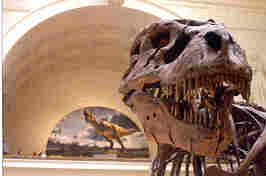
"Sue" at Chicago's Field Museum
After many years working, I had the opportunity to go back to school. My undergraduate is in biology (NEIU '93) and my masters in earth science (NEIU '96). I switched because geology is in my soul. My masters thesis examined the Permian-Triassic apparent mass extinction; known to earlier writers as the decline of the amphibians and the rise of the reptiles.
From 1996 to 2001, I taught geology at Morton Arboretum, Trinity Christian College and Northeastern Illinois University. It was a heavy schedule but I also volunteered for Project Exploration, an inner city program founded by Dr. Paul Sereno and Gabe Lyon. I adored my students and cherished our time together, but health reasons forced me to leave Chicago.
In May 2001, as my husband and I prepared to move to California, I sent all my friends an email saying something like "hallelulia, I'm a bum!" and didn't check my mail for a week. When I did, I found an email from Paul on expedition in Mongolia asking me to go to Wyoming and assist him with his summer class "Stones and Bones." In addition, he wanted me to go out with Gabe in early June to see the ranch and get a feel for the place, the people and the Lance Formation.
So on May 29, I left Chicago, arrived in California on June 4, received my furniture on June 6 and the next day left by air for South Dakota where I met Gabe at the airport. The next morning we drove to the Zerbst Ranch in Wyoming.
Our first stop was a layer of dinosaur tracks and trackways. Arlene Zerbst told us how her husband Leonard had excavated the trackway before his untimely death in 1999. She showed us that there are two kinds of tracks; three-toed tracks and round tracks. There are also some odd impressions which may be skin from dinosaurs rolling around, and a pair of dents and gashes which may be from horned and frilled dinosaurs pushing themselves up out of the mud. All this is highly speculative - the animals have been gone for about 65 million years.

Arlene and Gabe at the trackways.

Rachel made trackways for her presentation.
Interpreting tracks and impressions can be tricky. If some of the tracks are missing, the dinosaur may be interpreted to have a longer stride - or be taller than it really was. Some things which look like skin may just be mud drying patterns. And, of course, we really don't know which dinosaur made which track but you can stay busy for hours staring at these things and imagining that long-gone Mesozoic world. Arlene and Gabe put some hardener on some of the tracks which were getting loose and I measured the big three-toed tracks with my hands - each toe was twelve inches long!
Walking back to the pickup, Arlene showed me loose dinosaur bone laying on the ground. I leaned forward and took the photo on the left, then stood up and took the photo on the right.
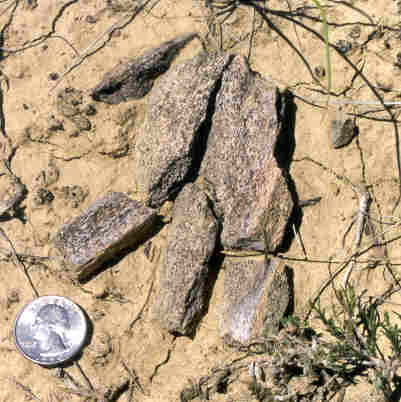
Bones with a U.S. 25 cent piece for scale.
There is bone everywhere on this hillside, just eroding out and tumbling down the gully. My fears of "not finding anything" evaporated as Arlene showed me how to tell the difference between plant eaters bones and meat eaters bones. Herbivore bone is wide open and spongy compared to the carnivores.
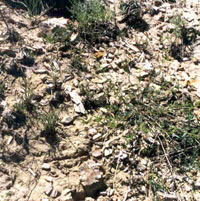
Just about every piece is part of a bone.
As if this wasn't enough for one day, Arlene next took us to see a group of rocks that everyone interprets as a Tyrannosaurus rex in blocks of extremely hard sandy siltstone laying out in lonely splendor on top of a hill.
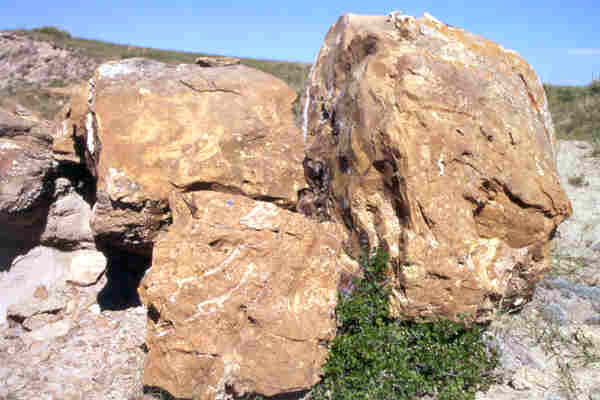
The "rex blocks."
These "rex blocks" have been known since at least the 1950s. Arlene later showed us a clipping from the local farm newspaper which showed the blocks and talked about all the other fossils on Zerbst Ranch. This gold-colored rock is everywhere on the Ranch. Usually it caps softer sandstones; here the sandstone has eroded and the capstones were laying on each other where they had fallen.
I was amazed. I guess I imagined that dinosaurs always came neatly laid out. Perhaps Paul and Gabe's photos from Africa had influenced my imagination. I never imagined dinosaurs in hard rocks like this. But these blocks may contain the answers to several puzzles about the tyrant lizards. The border line between the inside and the outside of the dinosaur shows clearly and one block had practically a cross-section of the dinosaur's gut on display. Unfortunately because they have been known for so long, many pieces have wandered away; we were fortunate to locate some of them on this trip. Ultimately they will be reunited in the final specimen.
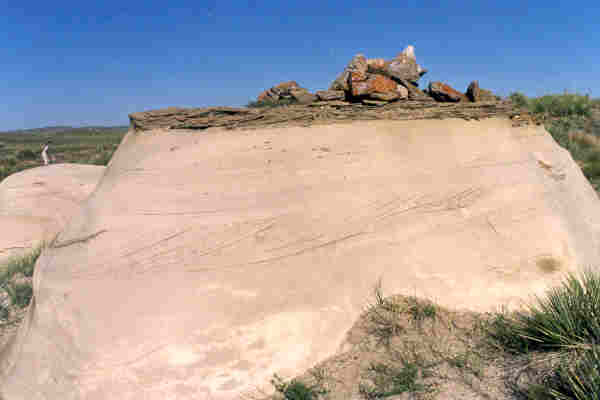
Kris' microsite. Note the person on the horizon at left.
We returned to the Paleo Park lodge and met Kris Stauffer, Arlene's daughter, and her husband, Chad. Kris put us in her pickup truck and we went back out and visited a "microsite" on their property. A microsite is where tiny things are found. I found an herbivore tooth, some small pieces of turtle and a 3 millimeter knucklebone. Gabe told me the knucklebone was the best thing I found - even though it was so tiny. What a day!
Kris also took us to another amazing place where a Triceratops is being picked out of solid rock by workers from the Black Hills Institute. This Triceratops has skin impressions! The Zerbst Ranch was the source of the "duckbill mummy" excavated by the Sternberg family in the early 1900s and on display at the American Museum of Natural History in New York ever since.

This impression is one of the few in the world to have preserved detail of Triceratops skin.
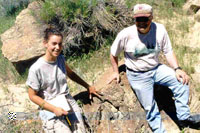
Gabe and Stan with a raptor footprint.
The next day, we went south to Stan and Claudia Swanson's ranch. They raise buffalo instead of cows and have dinosaur fossils on their land as well. Here Gabe points out a large three-toed dinosaur print she found while we were walking around looking at another fossil on Mr. Swanson's ranch.
Stan told us a lot about buffalo. In June, they are shedding their winter coats, so this fellow looks a little raggedy. When we visited in July, the buffalo had lost all their loose pelt. We saw young bulls and mothers with calves. They are so huge and so beautiful. And Stan's land looks great, too. Less sage than elsewhere and few cow trails. Buffalo don't walk single file along the fences like cows.
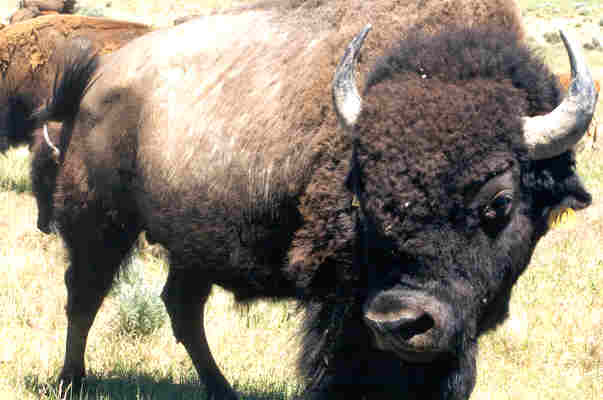
Buffalo are bigger in real life than they look in pictures.
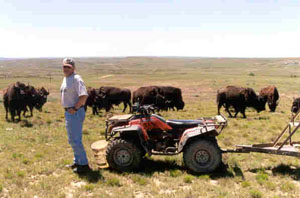
Stan Swanson and his critters.
Buffalo are smarter than cows. Stan brought out his four-wheeler with a "cow cake" dispenser on the back. Once it was empty, several of the females tried to get more by pulling the dispenser chain. Buffalo are faster and more delicate on their feet than cows and they seem much more interested in us than the average cud-chewing bovine.
We did so much in just a few short days! We prospected some more with Arlene and Kris. We visited the Black Hills Institute and met Neil and Pete Larsen and Bob Bakker at their annual fundraiser. We collected maps and data from the county seat. We met other paleontologists working in the area. And then, it was time to go home.
Ellin Beltz / ebeltz@ebeltz.net Originally posted: August 23, 2001
Updated: September 16, 2006